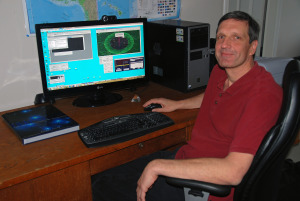
FLI Goes to the Edge
Finger Lakes Instrumentation is once again in the limelight with the detection of what is believed to be the oldest & most distant object ever observed. The image below shows the FLI ProLine PL4710 (Deep Depletion) Cooled CCD Camera mounted on the telescope Dr. Sasse used.
Dr. Christian Sasse, German-Canadian, Physicist-Engineer, keen astronomer and all round good guy, stumbled on the idea to see the edge of the universe due to his acquaintance with fellow Canadian, Paul Boltwood (works at Maxim DL) who according to Christian, “inspired me (without him knowing) to go even further than his record for the faintest object.” So Dr. Sasse embarked on a project that took much personal effort and over two years of attempts.
He commissioned the fabrication of a new star machine that he felt certain would allow us ‘amateurs’ to peer back in time, to galaxies far, far away. Actually…a certain quasar in Ursa Major, powered by a super massive black hole 3 billion times the mass of our Sun.
WhenJ1148+5251 was first detected by Earthlings in 2003, it was crowned as the oldest & most distant object ever observed. An ancient quasi stellar object with a redshift of z=6.41 and thus its light has been travelling for around 12.79 billion years towards Earth. Its redshift is so large that it has no ‘visible’ magnitude as such!
This monster roared into existence with brutal cosmic power only 870 million years after the universe began. Sending out infrared luminosity over 22 trillion times brighter than our own mediocre star. Forming a huge bubble of carbon monoxide molecules 30 million light-years in diameter around its host galaxy.
* We would like to thankGlobal Rent A Scope (now iTelescope.net) for the included information.
The Discovery
This week Christian pointed the newly commissioned the G17 Deep Red Telescope based at theGRAS-Astrocamp facility in Spain, to an otherwise blank piece of sky. G17 proceeded to capture a few hundred thousand very old photons on its CCD camera during 16 hours of exposures (199x300 secs). The first signs of the quasar appeared after about 2 hours of exposure.
It should be noted, that this object is not amplified gravitationally by lensing. No short cuts here.
Christian explained, “The G17 telescope was designed to extend the vision of amateur observing. The combination of a world-class telescope with superbly collimated optics (17” Planewave) mounted on the legendaryParamount ME, anFLI CCD with extended red sensitivity and a set of specialistfilters has made my dream come true. Now an amateur can reach magnitudes beyond 23.”
Data was processed via Maxim DL and VPhot. The image was plate solved using PinPoint 5.1, and reference stars/galaxies matched and identified from the NASA/IPAC Extragalactic Database.
The observation was reviewed and validated by Dr Ed Wiley (Kansas University) shortly after the data was collected.
As far as we at GRAS know, after much research, Christian Sasse and G17 have shattered a world record for amateur astronomy; the most distant amateur observation ever achieved on a truly accessible, amateur sized telescope.

Close Up - J1148+5251 Quasar in Ursa Major - 12hrs total exposure

